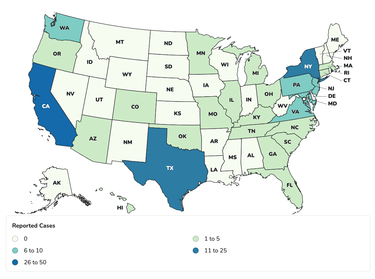County confirms case of typhoid fever at Guilderland Elementary School
— Map from the CDC
Reported cases of Salmonella Typhi, which causes typhoid fever, most recently mapped by the CDC in 2020, are rare in the United States. That year, with 157 cases reported nationwide, California had the most cases, at 46, followed by New York at 20, and Texas at 11. Almost all of the cases come from foreign travel. The true number is likely much higher, the CDC says, estimating 5,700 illnesses annually.
GUILDERLAND — A case of typhoid fever at Guilderland Elementary School was confirmed this week by Albany County’s health department.
The risk to the school community is low, Superintendent Daniel Mayberry stressed in a Sept. 24 notice to parents, posted on the district’s website.
The infected person, whose name and role at the school was not disclosed by the district, “is receiving medical care, is recovering well, and will remain home until fully cleared by both their doctor and the health department,” Mayberry wrote.
No additional cases have been identified, he said, adding, “Although the person did not have symptoms at school, typhoid bacteria can sometimes be spread through stool even without symptoms.”
Mayberry’s missive continues, “People can become infected by eating or drinking food or water contaminated with stool from someone who carries the bacteria. Most cases are mild and treatable with antibiotics. Serious illness is uncommon.”
The genus “Salmonella” was named after Daniel Elmer Salmon, an American veterinary pathologist who was the administrator of the United States Department of Agriculture research program, although it was Dr. Karl Joseph Eberth who first discovered the bacillus in 1880, confirmed by other German and English bacteriologists.
Immunization against Salmonella typhi was not developed until 1911, and antibiotic treatment was not available until 1948.
Before antibiotics, 10 to 20 percent of people infected with typhoid fever died of the disease; now, with prompt treatment, the case fatality rate is less than 1 percent.
The Centers for Disease Control and Prevention estimates that 9.2 million cases of Typhooid fever occur worldwide each year, mostly in places where water and food can be unsafe, and sanitation can be poor, including parts of Asia, Africa and Latin America.
Most people in the United States with typhoid fever were infected while traveling to these places, the CDC says.
While only about 350 people are diagnosed with typhoid fever nationwide each year, the CDC notes that number does not include people who do not seek medical care, who are not tested for the disease, or whose disease is not reported.
The true number of cases is likely much higher, the CDC says, estimating that 5,700 illnesses and 620 hospitalizations from Typhoid fever occur annually in the United States.
The most common symptom is fever and other symptoms can include weakness, stomach pain, headache, constipation or diarrhea, cough, or loss of appetite, the CDC says, while noting that some people get a rash with flat, rose-colored spots.
“Do not wait,” the CDC advises. “See a doctor if you have a fever and feel very ill.”
In his message to parents, Superintendent Mayberry advises, “If your child develops any of these symptoms, please contact your doctor and mention possible exposure to typhoid fever. If your child is sick, especially with diarrhea, please keep them home until they are feeling better and cleared by their doctor.”
Antibiotics can lead to quick recovery, lowering the risk of complications and death. The CDC goes on to advise, “Some people may not be able to return to work until a doctor says they no longer carry the bacteria. These people include healthcare workers, food handlers, and childcare workers.”
The Journal of the American Medical Association describes the two types of vaccines that are recommended for travelers to areas where typhoid is prevalent:
— Inactivated, or killed, vaccine, which is to be injected two weeks prior to travel and provides protection for two years; or
— Attenuated, or live, vaccine, which is ingested as four capsules, the last given at least a week prior to travel, providing protection for five years.
“Good hygiene is the best prevention,” Superintendent Mayberry writes and advises handwashing after going to the bathroom and before eating.
Mayberry goes on to reiterate the guidance that was prevalent during the COVID-119 pandemic on effective handwashing: “Wash with soap and water for at least 20 seconds (about the time it takes to sing “Happy Birthday” twice); rinse and dry completely.”
Mayberry concludes, “As we head into cold and flu season, this is a great time to reinforce these healthy habits at home.”



